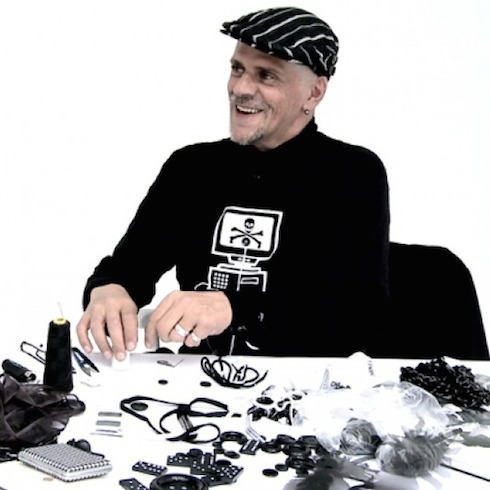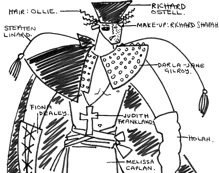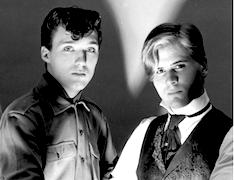➤ Tributes to fashion’s male iconoclast
who took a woman’s name
Posted on 21 February 2018
◼ THE VERY DAY THIS WEEK WHEN HM THE QUEEN put a smile on the face of the British fashion industry, by attending London Fashion Week for the first time, also brought the sad news of Judy Blame’s death, at the age of 58. He (yes, he) was one of those self-taught iconoclasts who was acquiring a luminescent reputation in the electric 1980s when Fashion Week came into being, driven in part by the streetwise youth culture that Shapers of the 80s celebrates.
Blame shared friends with the charismatic Ray Petri whose flair gave kudos to the word “stylist” by injecting attitude and dash into the role of the humble gofer who gathered props and make-up for a photo shoot. This was the generation of creatives who asserted their urban savviness and shifted the word style itself from meaning a suspect and second-rate lure with which marketeers sold their wares. By the end of the decade, style and fashion had become distinct goals in their own right, the first announcing individuality in consumer choice and mainstream media, while fashion confirmed convention.
Blame’s own talents as an image-maker were celebrated in 2016 at an Institute of Contemporary Arts exhibition titled Never Again which displayed his DIY jewellery, objets trouvés, clothing, photomontages, sketchbooks and T-shirts, and gave insights into working with Neneh Cherry and Massive Attack. Blame wrote on the vitrine titled Beautiful Chaos: “The layout for this display could easily be the surface of my desk when I’m working on a number of jobs simultaneously. This is an illustration of my working process and inspirations – from sketchbook to editorial and then through to the final product.”

Installation view at Judy Blame’s 2016 exhibition Never Again at the ICA. (Photography: Mark Blower)
That year 2016, W Magazine interviewed Blame and he reflected on working with Terry Jones MBE, founding publisher of i-D magazine in 1980: “The brilliant thing about Terry is his enthusiasm. Back in the day, you could drop by the office with quite a left-field idea, and if you were passionate about it, Terry just used to turn round to you and go, “Do it.” The classic example is I did a shoot on pollution, and I made all the models look like the birds being pulled out of the sea when there’s an oil disaster. Now, any other fashion editor would have gone, “You’re mad, I’m not interested.” And it could have all blown up in my face, but he saw it through to the end with me, and it really made a difference to the way people look at me and looked at the content of a fashion page.”
EXTRACTS FROM THE TRIBUTES TO JUDY

Booth shot: Judy Blame with his dear friend Scarlett Cannon before they launched the Cha-Cha club night in 1981
❏ Born Christopher Barnes in 1960 in Leatherhead, he was renamed Judy Blame by his clubland friends in the early 80s, “like a trashy B-movie actress,” Blame said, when the image-conscious New Romantic pioneers were making him more aware of fashion. He said the Garlandesque Judy was donated by designer Antony Price after spotting him working in the cloakroom of the gay megadisco Heaven, while his androgynous muse known as Scarlett Napoleon Bordello “came up with the Blame”. After he died on 19 February 2018, the news was broken by the same “glorious girl”, now known as Scarlett Cannon, his dearest friend and partner in fronting London’s Cha-Cha club-night 1981-82. She said this week: “I’m heartbroken but so happy to have had him in my life all these years. He left such a rich heritage of inspiration and touched so many people.”
Stylist and former Blitz Kid Kim Bowen wrote: “ The most magnificent Judy Blame has died. This most elegant of men defined so much about British fashion for most of his adult life. Those of us fortunate enough to have known him found him to be kind, acerbic, arch, clever – his mind as eclectic as his designs. ”
➢ A celebration, by Teo Van den Broeke at GQ magazine –
“ Originally renowned for his omnipresence on the London club scene during the 80s, in his later life Blame was known for his creative collaborations, his brilliantly avant-garde dress sense, his extraordinary homemade jewellery and his acid tongue. Blame was one of the founding members of Dalston’s House of Beauty and Culture – a space where creatives such as shoe designer John Moore, clothing designer Christopher Nemeth and photographer Mark Lebon would come together to produce.
“ Says Dylan Jones OBE, editor-in-chief of GQ: “Our relationship stretches back nearly 40 years, as I first met him in 1981, when he was still called Chris, in a squat in Brixton. We worked together at i-D for five years in the 80s, and over the years became as influential as any British designer, photographer or stylist. Never desperate for the limelight, he occupied a strange part of the industry, a Gatsby-like figure who retreated when the glare got too bright, but who had more tricks up his sleeve than most people who professed to do what he did. . . Essentially he was a terrific collaborator, someone who could bring out the best in other people. . . He was an artist, a genuine one, someone who could cherry-pick cultural detritus and then mix it all together to create something new, something lasting. ”
The Blame style – Click any pic below to enlarge and launch slideshow
➢ Caroline Rush CBE, chief executive @britishfashioncouncil –
“ The fashion world has lost a creative genius and many in the industry have lost a dear friend. His contribution to fashion, art and design saw him collaborate with music legends and fashion’s brightest stars. He was a true innovator and incredible part of London’s creative community. ”
➢ Nick Knight OBE, photographer and director of SHOWstudio –
“ Always totally unique, always a champion of the underdog, always fiercely anti-fascist and anti-establishment, always inspiring, always so immensely talented and always one hundred % brilliant. Judy, the world will be a much darker place without you but your life’s work will continue to shine and to show this world that creativity and art are the highest forms of human achievement. ”
➢ The editor-in-chief of British Vogue Edward Enninful writes –
“ When I was 18 years old, I moved into Neneh Cherry’s house in Kensal Rise with Judy Blame and our friend Michael Boadi. Judy had an amazing throne in the living room, but the most incredible thing about it all was that, whenever anyone came to visit London, they would somehow end up there. When I’d come home at the end of the day, I never knew who would be waiting there: people like Azzedine Alaïa, Jean-Baptiste Mondino, Glen Luchford, Juergen Teller, Leigh Bowery, Björk. . . These brilliant people were always turning up.
Judy gave us all pop culture through Boy George, through Neneh Cherry, through his remarkable music videos and editorial vision. His constant creativity was so inspiring – when I lived with him, he’d be doing something every day: sewing buttons onto clothes, making jewellery or scrapbooks – once he made me one, called The Black Book, for my birthday. It was filled with collages of black culture and memorabilia, and I treasure it. ”
➢ Nick Rhodes of Duran Duran – “ I am deeply sad to hear Judy has left us. He was a rare creature with a beautiful vision and undoubtedly key to sculpting the shape of style in the 1980s. His indelible fingerprints are all over the pop culture that followed. We worked together on the Wild Boys video where his contribution was spectacular. As both an artist and friend, his attitude, instinct and humour were a potent combination. ”
➢ Obituary in The Times – Judy Blame, causer of outrage –
“ An enthusiastic experimenter with unlicensed chemicals, Blame’s addictions put him in rehab more than once but towards the end of his life he cut an almost avuncular figure – albeit still a mischievous one. “After years of troublemaking with every part of my life, it seems the most radical thing you can do today is care for yourself and other people,” he remarked. Although a determined iconoclast, he also showed an unexpected reverence for tradition. “England’s really good at crafted, eccentric things,” he said. “We need to get back to that.” The sentiment could have been lifted from a manifesto for the arts and craft movement a century earlier. ”
➢ Former Blitz Kid and fashion editor, now professor of fashion Iain Webb in the New York Times Magazine, 2005 – “ If you were ever to make a movie of Blame’s life, it would definitely be a trashy, low-budget affair. In the late 70s and early 80s, London was the center of the night-life world, and Blame, who ran away from the Devon countryside at 17, penetrated its molten core. As the host of his own nightspot called Cha Cha, Blame wasn’t so much a party animal as a party monster: a catty hard act with a forte in withering looks and lines to match, fuelled by a cocktail of amphetamines and All About Eve repartee. Part diva, part demon, he was also the creator of divine accessories that had the ragtag bunch of attention-seeking style slaves dubbed the New Romantics swooning in their Otto Dix-meets-Sound of Music drag. ”
➢ An extraordinary and stylish presence, says deejay Princess Julia at The Queer Bible – “ Judy made things out of other things. Things that you wouldn’t immediately see as physical adornments but he made them so. His process was intense, over the decades I’ve watched him intently as he’s assembled together his signature pieces of discarded buttons, safety pins, old bits of string, oddments from a £1 shop, scavenged bits of discarded ‘rubbish’ and make something chic, an eye-catching necklace, brooch, a cap cascading with detail that you really have to study up close then stand back to get the full impact rather like looking at a painting.
I would love it when he would show me his latest project. He’d excitedly show and tell me this and that, his twinkling eyes glinting and his dry wit making us laugh hysterically, those fluoro pink toy-soldier necklaces he did for Comme des Garçons, the ragged key chains and that time he went out adorned with a frilly lady’s g-string as a mask. He loved to make a statement. ”
Judy Blame himself: “ Punk rock – that was my training. Whatever I’ve done, I’ve had to pick it up and work it out for myself. And because I wasn’t trained, I haven’t got that baggage. Training can hold you back. Especially with fashion. ”
EXTRACT FROM GUARDIAN ONLINE, 20 FEB 2018:
➢ So much purpose. So much talent – Tribute by Paul Flynn –
“ Most people know of Judy Blame, who died on Monday, aged 58, for his era-defining work styling and art-directing his closest friend and creative ally, Neneh Cherry. Back then, in 1989 Neneh was Britain’s brightest, freshest riposte to the knock-off, B-boy culture of 80s Canal Street New York. With Blame she appeared fully formed, a swaggering cross between Jean-Michel Basquiat and Roxanne Shanté. Leaf through your record collection – Björk’s Debut, Cherry’s Raw Like Sushi – and you will probably find you already own a piece of Blame’s wonderful art world.
My favourite Blame story, though, was his blowing the budget for dressing the extras in Duran Duran’s Wild Boys video, then spending the night before filming scavenging the Hoxton streets for rubbish to stitch together. It set the template for what was to come – everything he achieved in his stuffed bank of work. Blame’s vaults run deep. Pictures, moving images, trinketry, clothing, his breathtaking assemblage of everyday items as high-class jewellery.
My generation learned about fashion from Blame and his old friend Ray Petri, the two people most responsible for the gallant watermark drawn in British street fashion that was the Buffalo movement. When Buffalo Stance became a hit for Neneh Cherry, they lifted its cerebral ethos from the pages of niche, independent fashion magazines to MTV and then the world. Petri didn’t live to see his influence live on everywhere. But Blame did. He worked with Marc Jacobs, Kim Jones and Christopher Shannon, all acolytes and apostles of the celestial Blame way. Most recently, his handiwork made it to Moschino under the tutelage of another of the reams of his disciples, Jeremy Scott. Fashion editors adored him.
As for Blame, he was a towering collusion of the British pop riot at its most provocative, metropolitan, countercultural and, yes, often its most beautiful. ”

Click on this image to open a video interview in another window. . . In 2010 stylist Judy Blame took up residence in the LiveStudio space, creating a unique selection of jewellery and accessories inspired by the SHOWstudio Shop exhibition Blackwhite. This video documents the process of creating a monochrome array of artefacts in a postmodern bricolage style that became his trademark
TAGS – accessories, Blitz Kids, Buffalo movement, Cha-Cha club, fashion, House of Beauty and Culture, homosexuality, interview, jewellery, London Fashion Week, New Romantics, style, pop videos, Björk, Judy Blame, Kim Bowen, British Fashion Council, Teo Van den Broeke, Scarlett Cannon, Neneh Cherry, Edward Enninful, Paul Flynn, Julia Fodor, Guardian online, Institute of Contemporary Arts, Dylan Jones, Terry Jones, Nick Knight, Jean-Baptiste Mondino, Ray Petri, Paco Rabanne, Nick Rhodes, Caroline Rush, SHOWstudio, The Times, Nicola Tyson, Vogue, W Magazine, Iain R Webb















